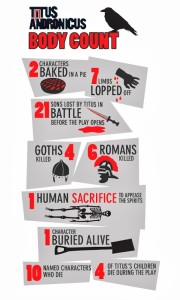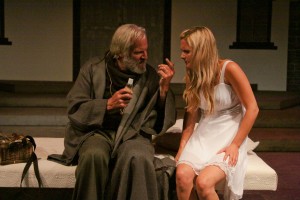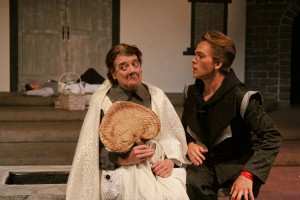Don’t Trust Your Mentors – A Review of ROMEO AND JULIET at the Marin Shakespeare Company
July 31, 2014 § Leave a Comment
Romeo and Juliet is generally interpreted as a tragedy of youthful impetuousness, but thanks to two exceptionally powerful performances from supporting players Marin Shakespeare Company’s current production is, instead, an unconventional reading of the play as a tale of adult betrayal.
Youthful Leads
On its surface, Lesley Schisgall Currier’s production is generally traditional, although with a few interesting moments of intentional anachronism thrown in. Jake Murphy (Romeo) is genuinely youthful, on a summer break from pursuing his undergraduate degree, and onstage he seems believably adolescent. Romeo is a notoriously difficult character to play successfully as most young actors have trouble catching both the lover and the fighter in him. Murphy is more believable as the latter, but the depth of his passion grows near the end of the play and his suicide, which he played with both fear and gravity, was harrowing.
Luisa Frasconi is cast against type as Juliet. Her forte is comedy. She is wonderful as Phebe in As You Like It, the other play in rep at Marin, and was winning in The Liar at Livermore Shakespeare Festival last summer. She does not overly indulge her comic impulses in this production, but her broad physicality and her “Betty Boop” voice occasionally work against our taking her seriously. Although interesting enough in most ways, if the production had depended on them alone for its impact, these leads would lack the tragic stature needed to carry the evening.
More than Just Support
But in intriguing ways, Currier’s production is not focused on them. The early moments of the play are built on the power of the always-dependable Scott Coopwood as the Chorus that delivers the opening sonnet, and then as the Prince of Verona. Teddy Spencer as Tybalt and Jackson Currier as Mercutio both find very sinister readings of their characters and propel the middle of the play forward.
The production really comes into its own with the appearance of Julian Lopez-Morillas as the young couple’s spiritual guide and confidant, Friar Lawrence. (Last summer Lopez-Morillas, as the leading character Hieronimo, brilliantly carried this company’s production of the rarely-produced Spanish Tragedy.) This Friar Lawrence was strongly conveyed because Lopez-Morillas speaks Shakespeare’s verse exceptionally well, but the character was also interpreted as bright, insightful, and genuinely concerned for the welfare of the young couple. There was no doubt that his intentions were pure – that is, until the last moment. When he might have saved Juliet’s life, he callously abandoned her in a desperate bid for his own safety. The betrayal was shocking.
The most brilliant turn of the evening was delivered by Debi Durst, the queen of San Francisco’s improv comedy scene, as the nurse. She delivered everything that her reputation would suggest: hilarious as a chatterbox that cannot be quieted in her first scene, the bawdy equal of the young men who later accost her in the street, and fussily silly when withholding information from Juliet about Romeo’s intentions to marry her and her coming wedding night.
She is so charming and funny that, even if you know the play well, you are unprepared for her reaction in the moment when Juliet seeks an ally against her tyrannical father (played by the company’s artistic director, Robert Currier.) In this central moment, Durst smoothly slides into the recommendation that Juliet quietly pretend her marriage to Romeo never existed and bigamously marry the wealthier Count Paris without so much as a backward glance. I’ve seen this moment played as consciously venal, and as completely opportunistic before, but Durst’s rendition clearly revealed the desperation with which she held onto her small position in a grand household as her only defense against a life of exponential loss. It was much more than the ability of a comedian to reveal the pain underneath the laughter: it seemed stunningly contemporary: in a bad economy down-and-out elders will sell out their protégés in an instant if it buys them even a little while longer on the trickle-down fringe.
Mostly Cloudy with Scattered Silliness
The combined impact of Lopez-Morillas and Durst was such that the play seemed to mean something insightfully different than the message it usually delivers. Instead of a warning about the rashness of youth, this performance seemed much more concerned with the danger of their gullibility about the “benevolence” of their elders. At least in this production, times are tough and an entire generation is abandoned to its own devices. Currier seems to suggest that far from a tragedy of fate, the loss of these two innocent teenagers was entirely preventable by trusted mentors who failed to step up to the plate.
This dark vision generally permeated the play, although Adam Roy (as the clown character, Peter) pushed hard in the opposite direction. On opening night he was clearly an audience favorite, as he had been as Touchstone in As You Like It. It is a performance I liked much less than those around me – worrying that he was frequently stealing focus and diluting the cynicism with which this production is infused – but it is only fair to say that I seemed pretty much alone in this assessment.
This is a company that places its emphasis on acting instead of spectacle. Jackson Currier is credited with the inoffensive set design, although only in the set decoration was it any different from the one used in As You Like It, credited to Joel Eis. Abra Berman’s black-and-white costumes were more aesthetically suggestive, achieving their impact in contrast to Romeo and Juliet’s blood red final apparel. Maxx Kurzunski’s lighting was little more than general illumination, and seemed to bear a curiously inverse relationship to the logical amount of light the scenes needed. (The gloomy crypt was the most brightly lit scene of the evening. Go figure.)
As You Like It
Marin Shakespeare Company
Directed by Lesley Schisgall Currier
Attended July 26, 2014, playing through Sept. 28
Tickets: $12-35 or “pay your age”
Info: marinshakespeare.org
Review: THE SPANISH TRAGEDY at the Marin Shakespeare Company
July 25, 2013 § Leave a Comment
A 425 Year-Old Debutante
For fans of Shakespeare and his contemporaries, the warmth of summer brings in the feasting season. Dessert this year is the Marin Shakespeare Company’s production of the rarely performed Thomas Kyd masterpiece, The Spanish Tragedy. (In fact, after 425 years it is said to be making its Northern California debut.)

Hieronimo, Knight-Marshal of Spain (Julian Lopez-Morillas) mourns for his murdered son Horatio (Erik Johnson) in Marin Shakespeare Company’s outdoor production of Thomas Kyd’s “The Spanish Tragedy.”
Photo by Eric Chazankin
The plot of Kyd’s revenge tragedy has more than a passing resemblance to Hamlet, a comparison from which it usually suffers but which also supplies it endless fascination. Although its date of composition is uncertain most scholars place it in the mid-to-late 1580s at just about the same time Shakespeare was probably starting his career in London. It is some dozen years older than Shakespeare’s Hamlet, a model therefore, and not a copy.
Spanish Tragedy opens with a ghost seeking revenge – accompanied in the play by a character named Revenge, in fact. It also features a doubting and delaying revenger who feigns madness to buy time, a woman driven genuinely mad by loss who eventually commits suicide, and a decisive play-within-a-play. Solely on the evidence of this resemblance, in fact, Kyd is believed to be the author of the mysterious ur-Hamlet, the now lost play on which Shakespeare is thought to have based his version.
The misfortune of the Spanish Tragedy is that through most of the twentieth century it was usually studied not because it is the progenitor of the revenge tragedies that dominated the Elizabethan stage, although it is, but as a less subtle comparator to Hamlet, useful for teleological arguments “proving” Shakespeare’s genius. Theater companies have had little incentive to produce it because the inevitable criticism is that it is nothing but a sensational oddity from the dustbins of history.
Body Counts and Comparisons
Among the things that becomes clear from watching the play in performance in Marin (from an edition prepared by the company’s skillful dramaturg, Mary Ann Koory) is that Hamlet is the wrong comparator. It is far more like Shakespeare’s first – and decidedly unsubtle – revenge tragedy, Titus Andronicus. It has a plotting Iago-ish Machiavellian character at its center, like Titus’ Aaron. The revenger is not a son, but a father, like Titus. A powerful woman drives the plot forward, like Tamora. Most of all, it is not structured around introspective monologues, but (exactly like Titus) around grisly and horrific violence – lots and lots of violence. If you are not familiar with Titus, the Royal Shakespeare Company has prepared a helpful graphic of the body count for its current production, attached here.

The Royal Shakespeare’s infographic of the Titus body count, to which Spanish Tragedy is a worthy rival.
Similarly, The Spanish Tragedy begins with a murdered minor nobleman, Don Andrea, tallying the deaths from a war in which, by the rules of chivalry, he would have been taken prisoner for ransom instead of killed. It proceeds through the onstage murder of a bound victim, two ambushes of unsuspecting co-conspirators to eliminate witnesses, a narrowly averted burning at the stake of an innocent man, an unexpected hanging of a guilty one who thought he had bribed his way to freedom, an offstage suicide, a final scene with so many deaths that it leaves the lines of succession of both Spain and Portugal destroyed, and the hero biting out his own tongue so he cannot be forced to confess!
Before “To be, or not to be” there was “Oh eyes, no eyes”
Titus, of course, was not held in high esteem until very recently, when it began to be judged by its own Senecan aesthetic aims instead of belittled for not being more like the late tragedies. Ironically, it was Shakespeare’s most successful play in his lifetime. It did not hold a candle to Spanish Tragedy, however, which was the most successful play of the entire period. It has more recorded performances and more references in plays, poems, and diaries than any play before the Commonwealth. What “To be or not to be” is to us now, the protagonist, Hieronimo’s, great speech “Oh eyes, no eyes, but fountains fraught with tears” was to the early modern audience then.
Julian Lopez-Morillas plays Hieronimo with a riveting intensity throughout, but his delivery of the famous monologue confirmed its still current fascination, as he used it to shift the action into a higher gear. His dark humor and grisly determination had the same kind of power that Antony Hopkins brought to Julia Taymor’s filmed Titus. In his hands we begin to see what all the fuss was about.
Few in the cast could keep pace with him, but Elena Wright was an intriguing (in both senses of the word) Bellimperia, the female lead around whom much of the plot turns. Female characters from the period generally do not have the agency and intensity that Bellimperia has, and Wright reveled in the chance to play her strength. Erik Johnson was a very charismatic Horatio, the young man in love with her, and the presumed revenger, until he is captured and casually murdered in front of her (and us) midway through the play. Scott Coopwood played Bellimperia’s father, a particularly complex role, notably.
It is carping to note that much of the rest of the very large cast was less experienced, since the economic reality is that is about the only way any company could afford to mount this show. The divide between the professionals and the others was wide, however, and both the pace and the verse speaking suffered often because of it. The production’s strengths were heavily invested in the protagonists, unbalancing the action when the antagonists were (at least theatrically) not their match. A surprising set of comic characters who seem to have wandered into the tragedy from Much Ado, however, helped to energize the second half.
Beautiful Executions
Set Designer Shannon Walsh created a beautiful and varied Spanish compound, but for some reason chose not to structure any visual relationship between the three sets of gallows for major executions that sub-divide the play into acts – often thought of as the main visual motif of the play. Costume Designer Abra Berman gave us authentic period appearances for the characters, especially effective in visually aiding the audience to keep track of the complex alliances and shifting locales.

The murder of Hieronomo’s only son, Horatio (played by Erik Johnson, pictured), sets off a chain of murderous events in Marin Shakespeare Company’s outdoor production of “The Spanish Tragedy.”
Photo by Eric Chazankin
“Where Words Prevail Not, Violence Prevails”
Only in the final moments of the play did the production completely rise to the occasion, bring home to message encapsulated by its most famous line. When it blossomed into its full potential, however, it was easy to see why the vicarious power fantasy of revenge, and the sensational violence, was as popular as it was. In much the way that Titus has been rehabilitated in the last half century after nearly three hundred years of dormancy, The Spanish Tragedy seems ripe for rediscovery. The combination of black humor and suppressed rage at state sponsored (or at least tolerated) injustice – of which poor Kyd as a victim when he was tortured and his health permanently destroyed as collateral damage in the campaign to ensnare Christopher Marlowe – was not a Victorian taste, but seems all too apropos these days. We can only thank and admire Marin Shakespeare Company for exploring this gem.



